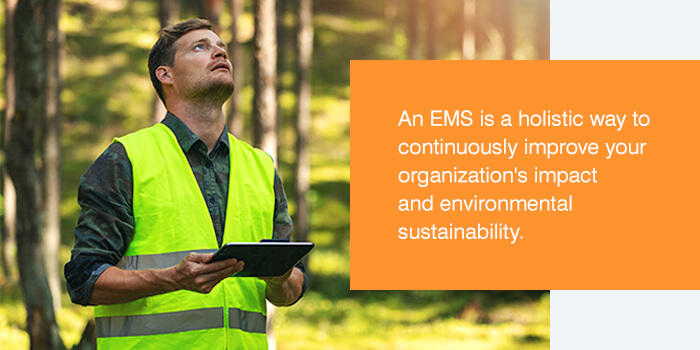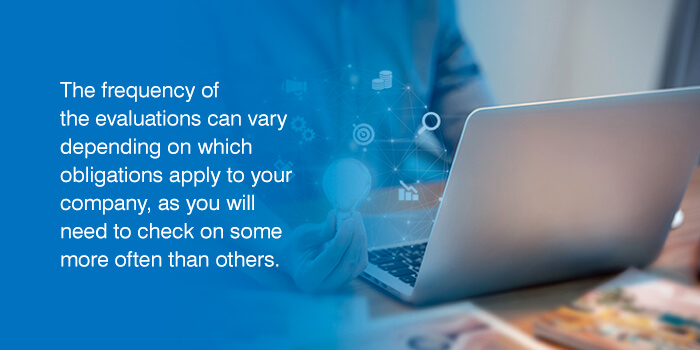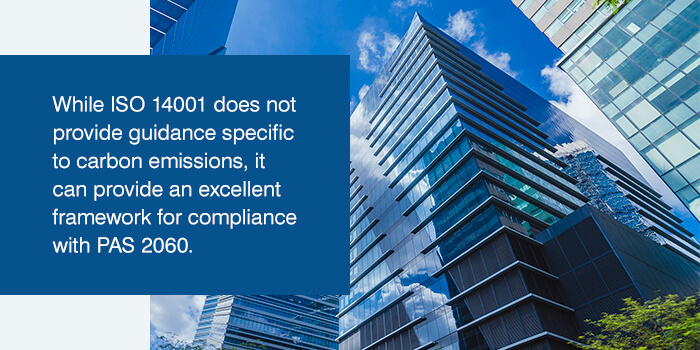How to Evaluate Compliance With ISO 14001:2015
Our regional Principal Assessor for Environment and Energy - Richard Walsh talks about the evaluation of compliance within ISO 14001 and the common misconceptions that may occur within the clauses.
Evaluating ISO 14001 compliance is often challenging for organizations because, in many cases, the process is difficult to understand. Many believe that the standard only requires updating a legal register every time the government amends a piece of legislation, but the actual requirements are a little more involved.
In the 2004 standard, clause 4.3.2, Legal and Other Requirements covered this requirement. The updated 2015 standard places it under clause 6.1.3, Compliance Obligations.
Let's discuss how to evaluate your organization's compliance with ISO 14001:2015 and clarify some common misconceptions of the standard. Then, we can dive into the related PAS 2060 carbon neutrality standard and how it can help your company.

What Is ISO 14001?
ISO 14001 is an international standard from International Organization for Standardization for environmental management systems (EMS), which are frameworks a company can use to achieve its environmental goals. Essentially, an EMS is a holistic way to continuously improve your organization's impact and environmental sustainability. ISO 14001 is the most widely used EMS in the world, with more than 360,000 certificates issued globally.
What Does Compliance With ISO 14001 Mean?
In short, complying with ISO 14001 means following the rules of your EMS. ISO 14001:2015 requires organizations to follow legal requirements as well as their own voluntary environmental obligations.
- Legal obligations: ISO 14001 includes requirements for environmental policy, which means the EMS you develop must ensure your compliance with legal requirements for environmental protection. These are the regional, national and international laws that apply to your organization. For example, according to the United States Clean Water Act (CWA), discharging pollutants into navigable water sources is unlawful without a permit. Obtaining a permit to discharge pollutants is therefore your legal obligation.
- Voluntary obligations: Your EMS might also include certain obligations that your organization commits to beyond the legal requirements. ISO 14001 includes certain requirements to help you manage these voluntary obligations. These are the obligations that your organization chooses to follow as part of its mission. For example, you may be eligible for a permit, but you might find that you don't actually need to deposit pollutants into water sources. Your voluntary obligation, then, would be to stop polluting waterways by using another, more sustainable method of removing waste.
If you are unsure of your legal obligations, there are two steps you can take to determine what you need to do to be compliant:
- Identify and provide access to applicable legal requirements: Make sure you're familiar with all environmental legislation related to your company. Keeping up with the ever-changing legal landscape can help you form a framework for evaluating compliance.
- Understand how this legislation applies to your organization: Determine how applicable the laws are to your situation and document how it affects you. The standard requires thorough documentation regarding compliance obligations, so keep yours up to date.
Now that you know what you need to do to ensure your organization's compliance, section 9 – Performance Evaluation – requires that you evaluate the effectiveness of your sustainability standards compliance.

How to Evaluate Compliance With ISO 14001
However you choose to evaluate your organization, you will need to consider how often you will do so. The frequency of these evaluations can vary depending on which obligations apply to your company, as you will need to check on some more often than others. For example, you will need to examine your effluent discharge levels more often than your recycling numbers. Your frequency can also depend on your organization's industry and economic sector, as some have higher environmental impacts than others.
Once you know this information, you can begin your evaluation. ISO standards follow a "Plan-Do-Check-Act" (PDCA) cycle to evaluate and maintain compliance. This cycle ensures the continual improvement of the organization in question and creates a culture of compliance by encouraging regular checks and improvements.
You should follow these steps in your initial evaluation:
- Appoint an auditor: Select an individual or team to perform the review. Your auditors can be either internal or external as long as they are competent– this means that they are familiar with environmental regulations applicable to your location and industry.
- Assess your business: Your chosen party will check your procedures and pollution levels against the guidelines of your EMS. They will use this information to decide whether you are compliant or not.
- Report your findings: Your auditor must submit their findings to top management so that they are aware of any instances of noncompliance. Recent ISO standards emphasize the role of leadership in workplace effectiveness, so be sure to involve your company's top officers in the process.
- Create a new plan: If your auditor found instances of noncompliance, determine what steps you can take to fix them. Make sure to write your new policies down so you can refer to them later.
- Take action: Implement the new policies and procedures you outlined in the previous step. Alert all employees and managers to the changes so you can ensure the best chances of improvement.
- Reevaluate: How are these changes affecting your organization? Are they helping to solve the issues you noticed in your initial evaluation? Could these policies be more effective? If so, you should plan what steps you can take next.
In essence, your organization is compliant if you meet the legal and voluntary requirements outlined in your EMS. If you find instances where your operation is not meeting those goals, it is your responsibility to create a suitable solution.
Legal requirements inevitably change over time, so keeping abreast of legislative developments is key to maintaining compliance. When conditions change, you should know about it, and you should understand if it affects your compliance. If you make any changes in your facility unrelated to your environmental obligations, you should still reevaluate to make sure you meet all requirements both during and after the change.
Remember, you need to keep thorough documentation of these evaluations so that you and your auditors can easily access the information later. Keeping accurate, organized records will help you demonstrate your history of compliance and guide future evaluations.

ISO 14001:2015 and PAS 2060
PAS 2060 is an international standard used to verify an organization's claims of carbon neutrality. It builds on the already existing environmental standards of PAS 2050 and ISO 14001:2015 to help companies become truly carbon neutral.
Carbon neutrality is the ability to offset your carbon emissions either by natural carbon sinks, which are natural structures that absorb carbon dioxide, or by staying within your carbon credit limit.
While ISO 14001 does not provide guidance specific to carbon emissions, it can provide an excellent framework for compliance with PAS 2060. In essence, you can easily make your efforts towards achieving carbon neutrality part of your existing environmental management plans.
If you are considering making your organization complaint with ISO 14001, you should also look into PAS 2060 certification. Combining both standards can result in enormous benefits for environmentally conscious companies, including:
- Strengthened reputation
- Improved efficiency
- Reduced costs
- More business opportunities
Certification with both standards is ultimately advantageous to any business, as it demonstrates a commitment to both environmental health and corporate improvement.
How Can I Get Certified to ISO 14001?
If you want to certify your organization with ISO 14001, you can use our quick step-by-step guide. For more detail, check out our Guide to ISO 14001.
- Familiarize yourself with the standard: Make sure you understand all its requirements and terminology. You can purchase a copy of the standard here.
- Perform an initial environment review: Compare your performance to the applicable environmental regulations. Additionally, consider any indirect impact your operation may have on the environment.
- Conduct a gap analysis: Determine where you need to be for ISO 14001 compliance and compare that to where you are now. Establish what changes your organization can make to close that gap and get to your ideal level.
- Create a plan: Plan changes you can make to achieve your goals. Ensure your staff and management understand the changes you plan to make and train them on any new procedures.
- Build your EMS manual: Now that you and your employees know what you need to do, you can draft a manual that outlines your EMS in detail. This process will take time to complete. Provide a physical copy in your workplace so your employees can access it at any time, and keep a digital copy so you can easily edit it in the future.
- Implement your EMS: All employees should follow the procedures outlined in your manual. Keep track of your progress with the new system for at least three months before progressing to the next step. Additionally, make sure to train any new hires according to your new procedures.
- Perform an internal audit: ISO requires an internal audit before an official audit. This way, you can catch any remaining instances of noncompliance and fix them before receiving the official audit.
- Schedule and undergo your registration audits: Once you feel that your operation is ready, book an appointment with an accredited certifying body (CB). Your CB will conduct two rounds of audits to ensure your business is compliant with your EMS. After each audit, you'll receive detailed information about what you need to do to achieve compliance.
Once you pass your second audit, you'll achieve ISO 14001 certification. If you wish, you can combine this certification with other ISO standards like PAS 2060 to maximize the benefits you'll experience.
It's important to know that auditors from certification bodies are only required to audit how well an EMS meets the requirements of ISO 14001. They are not required to make direct evaluations of legal compliance. The organization being audited is wholly responsible for making sure they follow the law. Additionally, certification body auditors do not perform compliance audits. Environmental regulators or specifically contracted inspectors are responsible for fulfilling that purpose.
Get ISO 14001 Certified With NQA
As an accredited certifying body, we believe it's our responsibility to help businesses improve consistently and sustainably. You can trust our highly skilled staff to conduct your certification audits in a professional and timely manner.
Click here to get a free quote for ISO 14001 audits and certification, or contact us online with any additional questions.
